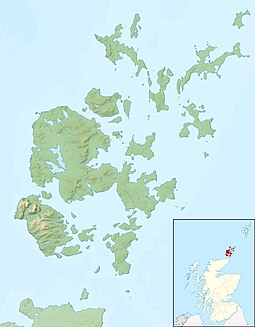Hunda
| Scottish Gaelic name | Unknown |
|---|---|
| Old Norse name | Hunðey |
| Meaning of name | Old Norse meaning 'dog island'. |
| Location | |
| OS grid reference | ND437967 |
| Coordinates | 58°51′N 2°59′W / 58.85°N 2.98°W |
| Physical geography | |
| Island group | Orkney |
| Area | 100 hectares (0.39 sq mi) |
| Area rank | 149 [1] |
| Highest elevation | 42 metres (138 ft) |
| Administration | |
| Council area | Orkney Islands |
| Country | Scotland |
| Sovereign state | United Kingdom |
| Demographics | |
| Population | 0 |
| References | [2][3][4] |

Hunda is an uninhabited island in the Orkney archipelago in Scotland. It is 100 hectares (0.39 sq mi) in extent and rises to 42 metres (138 ft) above sea level. It is situated in Scapa Flow and connected to the nearby island of Burray by a causeway built in 1941 to stop passage of small surface craft as part of the boom defences,[5] and thence to the Orkney Mainland via the Churchill Barriers.[6]
The name is derived from the Old Norse for 'dog island'. The Vikings made the Orkney Islands their headquarters for their expeditions against Scotland and Norway, and the islands were under the rule of Norse earls until 1231.[7] The island is rich in bird life,[2] and contains a disused quarry. A small inlet in the northern cliffs is known as 'Sunless Geo'.
Hunda is currently used to raise sheep and goats for wool.[8]
58°51′15″N 2°58′39″W / 58.85417°N 2.97750°W
See also
[edit]References
[edit]- ^ Area and population ranks: there are c. 300 islands over 20 ha in extent and 93 permanently inhabited islands were listed in the 2011 census.
- ^ a b Haswell-Smith, Hamish (2004). The Scottish Islands. Edinburgh: Canongate. ISBN 978-1-84195-454-7.
- ^ Ordnance Survey
- ^ Anderson, Joseph (Ed.) (1893) Orkneyinga Saga. Translated by Jón A. Hjaltalin & Gilbert Goudie. Edinburgh. James Thin and Mercat Press (1990 reprint). ISBN 0-901824-25-9
- ^ Boom defences are barriers to obstruct navigation, such as a chain or bar across a waterway.
- ^ Wenham, Sheena, The South Isles in Omand, Donald (ed.) (2003) The Orkney Book. Edinburgh. Birlinn. Page 211.
- ^ "Orkney Islands". Scotland Info. Archived from the original on 15 July 2014. Retrieved 14 July 2014.
- ^ "South Ronaldsay & Burray". Archived from the original on 19 October 2008. Retrieved 22 October 2008.
External links
[edit]

